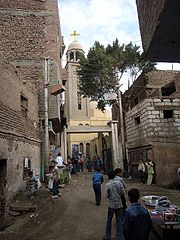| El-Bayahu · البيهو | ||
| Governorate | Minyā | |
|---|---|---|
| Residents | 17.069 (2006) | |
| height | 44 m | |
| no tourist info on Wikidata: | ||
| location | ||
| ||
El-Bayahu (Arabic:البيهو, al-Bayahu) is a village in Middle Egypt with about 17,000 inhabitants[1] in the governorate el-Minyā west of the Nile about 18 km north of the city el-Minyā or 5 km south of the city Samālūṭ. The village is inhabited by both Muslims and Christians. It is one of the most important pilgrimage sites for the Coptic Christians.
background
In the local church the holy ischyrion (also St. Ischyrion, Arabic:أبّسخيرون, Abbascheirūn) venerated. Ishyrion lived in the fourth century AD, was in the village of Qillīn (قلين) In today's governorate Kafr esch-Sheikh born and raised in Atrīb (أتريب) On. He later served the governor of Ansena, Arianus, as an officer. Under the Roman Emperor Diocletian, any practice of the Christian faith was forbidden by edict, which marked the beginning of the longest and most cruel persecution of Christians in history. Ishyrion was also required to renounce his faith. But he refused, quit his military service and was thrown into dungeon for it.
But nothing could change him from his belief, neither his two brothers, the trial in Asyūṭin which he was sentenced to death and the cruel torture. By virtue of his faith, tools of torture failed, or the Archangel Michael was able to protect or heal him in the furnace, by piercing eyes and by poisoning him. The magician Alexander, however, when he saw that his poison had no effect, converted to Christianity and was beheaded for it. Ultimately, Ishyrion's arms were cut off and he was beheaded.
Ishyrion and Alexander became martyrs whose memories will be preserved. The feast in honor of St. Ishyrion is celebrated every year on the 7th Ba’ūna (June 14th). Ishyrion is mentioned in the churches of his name in Anbā Bīshoi Monastery, in Asyūṭ and worshiped here in Bayahu. The relics of the saint are kept in the Anbā Bīshoi monastery and in the Anbā Ṣamūʾīl Monastery kept.
But one also reports of the miracle of the Transfer of the church from Qillīn to Bayahū. During the harvest season in Qillīn, weddings also took place every year. One day troublemakers tried to attack the villagers in the church. But nothing could happen to them because the church, together with its healing spring and tree, was moved to Middle Egypt. The villagers did not want to admit that, and they wanted to return to their village. The boatman who took the villagers to Qillīn, where the church was found to be absent, and then back to Bayahū, was amazed that under the influence of St. Ishyrion the journey took only a day instead of a week. He professed Christianity and bequeathed parts of his boat to the church.
St. Ishyrion will on icons as an equestrian saint with a lance, at the upper end of which there is a cross, shown. Furthermore you can see the relocated church with well and tree and a camel breeder who bequeathed the firstborn calves of his camels to the church.
getting there



The place can be reached by car or taxi. On the trunk road from el-Minyā to Samālūṭ one reaches one shortly before Samālūṭ 1 bridge(28 ° 15 '53 "N.30 ° 43 '45 "E) via an irrigation canal, which one leads in the direction of Iṭsā (Arabic:إطسا) Crossed. After a few kilometers you reach Bayahū. The church is at the position 1 28 ° 15 ′ 41 ″ N.30 ° 43 '54 "E..
mobility
The streets in the village are sometimes a bit narrow, the last few meters to the church have to be walked.
Tourist Attractions
The Abbascheirūn el-Qillīnī Church (كنيسة أبسخيرون القليني, Church of St. Ishyrion from Qillin) is in the middle of the village. The tower of the church is easy to recognize from its southwest corner. The entrance to the church, which is located within an enclosure wall, is also located at this point. This new church, around 50 years old, is located on the site of an earlier 5th century church.
The three-aisled church, which underwent a complete renovation in 2007, has few interesting details of its own. In the east is the icon wall, which is around 100 years old, but two strips of wood to the right and left of the central sanctuary (shark) come from the previous building. The three holiest of holies are all dedicated to St. Dedicated to Ishyrion. There is a relic near the iconostasis on the north wall.
If you leave the church in the north, you come to a courtyard, on the east side of which there is a building with a baptismal font and the healing spring. There are two inconspicuous wooden cupboards on the south side of the courtyard. The eastern one contains fragments of the church from the 5th century, e.g. a baptismal font. The cupboard on the other side contains wooden parts of the old church, e.g. a Haikal door, and parts of the feluka that the villagers used to travel to Qillīn and back.
In the village one should also be able to find other built-in components of the earlier church.
accommodation
Accommodation options exist in el-Minyā.
trips
A visit to the village can also be combined with a visit to the El-ʿAdhrāʾ monastery and the churches of el-Manāhra and Samālūṭ connect.
literature
- A brochure on the life of St. Acquire Ischyrion (St. Abba Eskhayron) in English.
Web links
- The Martyrdom of St. Abaskhiroun the Soldier, Coptic Synaxarium (Martyrologium) for the 7th Ba’ūna (Coptic Orthodox Church Network)
Individual evidence
- ↑Population figures according to the 2006 Egyptian census, Central Agency for Public Mobilization and Statistics, accessed November 7, 2014.


